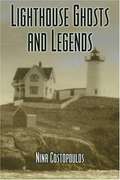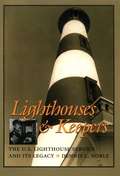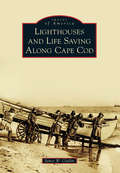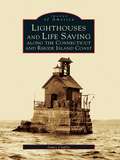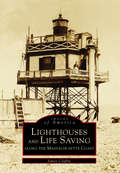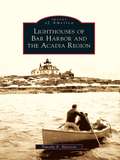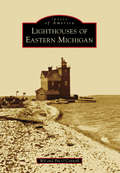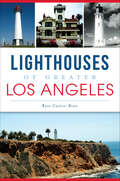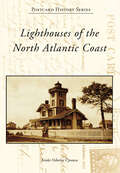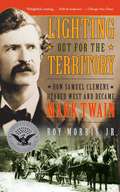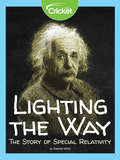- Table View
- List View
Lighthouse Ghosts and Legends
by Nina CostopoulosFrom the Book jacket: There is something mystical and romantic about the soft glow of a lighthouse spinning out across the ocean. Beyond that protective light, however, many of America's lighthouses are plagued by a dark history of vicious storms, violent shipwrecks, and, in some cases, even murder. Today, the ghosts of the past still linger in the lonely corridors of many American lighthouses, making their history known. In 1899, Muriel, the sweet-tempered daughter of a sea captain disappeared from the Yaquina Bay Lighthouse in Newport, Oregon, leaving behind only a small pool of blood and her white handkerchief. Today, she is seen on dark stormy nights and has been known to bolt the lighthouse door, allowing no one in-not even those with a key. The sounds of former Captain William Robinson's footsteps and the methodical tap of his cane can still be heard walking the corridors of the White River Light in Whitehall, Michigan. Ernie, the ghost of the former keeper of Ledge Light, near New London, Connecticut, polishes brass, swabs the decks, leaves tools about the lighthouse, and rearranges books on bookshelves. Following on the heels of Crane Hill's bestselling Lighthouse Ghosts, Lighthouse Ghosts and Legends brings fans of watery hauntings more of their favorite lore. Author Costopoulos weaves eighteen tales of mystery surrounding some of America's best known beacons, including St. Simon's Island, Alcatraz Island Light, Owl's Head Lighthouse, Hendricks Head Light Station, and more. Covering the extent of coastal America and the Great Lakes, Lighthouse Ghosts and Legends runs the gamut of sprites, spirits, mysteries, miracles, and madness.
Lighthouse Handbook New England 2nd Edition
by Jeremy D'EntremontFor those looking for guide and reference. Not another coffee table display of lighthouses, but a companion of travel.
Lighthouse Keeper's Daughter: The Remarkable True Story Of American Heroine Ida Lewis
by Lenore SkomalThe Lighthouse Keeper&’s Daughter is the absorbing, painstakingly researched story of Ida Lewis and the fearless rescues she made at Lime Rock Lighthouse in Newport, Rhode Island. Born in 1842, Ida began tending the light at age fifteen after her father, the keeper of the light, was disabled by a stroke. When her father died in 1872, Ida&’s mother assumed the role of lighthouse keeper but Ida continued to do the work. Then when her mother died in 1879, Ida was officially appointed to the job, where she remained until her death in 1911. Ida is credited with saving at least eighteen lives during her nearly forty years on the tiny island in Newport Harbor. She became famous nationwide in the late 1860s after one of her daring rescues, and the town of Newport celebrated her on Independence Day 1869. In 1924, the Rhode Island legislature officially changed the name of Lime Rock Lighthouse to Ida Lewis Lighthouse. In 1928, all but a portion of Lime Rock used for the light tower was sold to yachtsmen who preserved the historic house and established the Ida Lewis Yacht Club. In 1995, a Coast Guard buoy tender was named for her.
Lighthouse Tales
by Frederick StonehouseFrom the Book Jacket: Lighthouse Tales tells the story of the exciting human side of lightkeeping. It describes the deadly storms, killing fogs and numbing loneliness those who "kept the lights" endured. Stories of wreck and rescue, death and sacrifice, all thread their way through the pages of this remarkable tribute to the "wickies" of a bygone era. The book speaks of the courage of the old time keepers and their families, not just in rescuing shipwreck victims but also in the tenacity of their daily lives. Lighthouse Tales will appeal greatly to anyone interested in the wonders of the Great Lakes, historians, sailors, lighthouse fanatics and people just looking for a roaring good story. The book is thoroughly illustrated with rare photographs. Narratives include: The thrilling story of the steamer GEORGE W. PERKINS and it's close encounter with Lansing Shoal Light during the height of the infamous 1940 Armistice Day storm. Superior Shoal and the lighthouse that wasn't. The death of six brave Coast Guardsmen at Oswego, New York in 1942. Poverty Island Light and the mysterious treasure. And many more thrilling tales of "keeping the lights!"
Lighthouses & Keepers
by Dennis L. NobleFrom the East Coast to the West Coast, the Great Lakes to the Gulf of Mexico and Hawaiian Islands, this handsome book helps explain the lure of lighthouses in the United States. Among the most recognized structures of the maritime world, these lonely sentinels by the sea have long been the subject of paintings and photographs. Today they continue to capture public imagination as Americans flock to their sites for visits and volunteer to help preserve these endangered structures. This book covers all aspects of the subject, not only lighthouses and lightships but buoys, buoy tenders, fog signals, and their keepers. The work is as rich in historical information as it is in rarely seen photographs, and fourteen maps guide readers to the exact locations of the lighthouses. Readers are also treated to stories of shipwrecks and rescues, including the extraordinary story of Ida Lewis, head keeper of the light at Lime Rock, Rhode Island, who rescued eighteen people from the sea.
Lighthouses and Life Saving Along Cape Cod
by James W. ClaflinFor centuries, heroic men and women have guarded the treacherous yet beloved Cape Cod coastlines. From Provincetown to Chatham, Sandwich to Cuttyhunk, and many towns in between, residents have relied on the Atlantic for employment and nourishment. But Cape Cod has always been plagued with a shifting coastline that consistently defies mariners' efforts to pass through Massachusetts waters. In 1792, as shipping increased, mariners petitioned for a sorely needed lighthouse. It was not until 1797 that the first lighthouse on Cape Cod was built at the Highlands in North Truro. More lights and rescue stations would follow as the seas claimed their toll. Many lightship stations were also established from Chatham through Nantucket Sound to mark the constantly changing sandbars submerged offshore--more than in any other spot along the US coastline. Today, as sea levels change and sands continue to shift, some of these historic stations have been lost or moved, while still others are preserved only in such photographs as these.
Lighthouses and Life Saving Along the Connecticut and Rhode Island Coast (Images of America)
by James ClaflinLighthouses and Life Saving along the Connecticut and Rhode Island Coast is the third in a series of titles offering a unique tribute to the men and women who protected the mariners as they traveled along New England's rocky coastline. Thousands of vessels faced the dangers of the rugged sea which caused hundreds of shipwrecks off the coast with devastating losses. Author James Claflin combines a thoroughly descriptive text with this diverse collection of over two hundred vintage images, from private as well as museum collections, to create an illustrated history of an area strongly reliant on its coastal trade. The U.S. Light-House Establishment and the U.S. Life-Saving Service, which later merged to become the U.S. Coast Guard, assumed the responsibility of lighting and protecting the coasts. Inside, you will see the lighthouse keeper at Bullock's Point Light as he surveys the damage from the Hurricane of 1938, witness the life savers at Block Island's Sandy Point Station where first word of the wreck of the steamer Larchmont was received, and experience life on an offshore lightship. The book guides you through the days of the life savers-the work they performed, their rescues, and the evolution of their architecture through the years.
Lighthouses and Life Saving along the Maine and New Hampshire Coast
by James ClaflinLighthouses and Life Saving along the Maine and New Hampshire Coast is a unique tribute to the men and women who protected mariners as they traveled along New England's rocky coastline. With thousands of vessels plying the dangerous waters, the chance of a shipping disaster was always great. Hundreds of shipwrecks did indeed occur off the coast with startling losses. Through descriptive text and a variety of vintage images from private as well as museum collections, we get a rare glimpse into the lives of the dedicated government men and women.Author James Claflin combines an extensively researched text with this exquisite collection of previously unpublished images to tell the story of an area heavily dependent on its coastal commerce. The task of lighting and protecting the coasts was taken on by the U.S. Light-House Establishment and the U.S. Life-Saving Service, later merged to become the U.S. Coast Guard. Within these pages, see the Boon Island Lighthouse keeper, his family alongside, as he proudly poses in his uniform; life savers at Hunniwells Beach station as they pull through a blinding snowstorm to rescue the crew of a stranded schooner; and the way of life on an offshore lightship. Lighthouses and Life Saving along the Maine and New Hampshire Coast is a visual journey into our nation's maritime history.
Lighthouses and Life Saving along the Massachusetts Coast (Images of America)
by James ClaflinLighthouses and Life Saving along the Massachusetts Coast is a unique tribute to the men and women who protected mariners from shipping disasters. With a variety of vintage images from private as well as museum collections, this rare glimpse into the lives of the dedicated workers who protected thousands of vessels plying the dangerous waters of Massachusetts Bay and Nantucket Sound is a visual journey to an earlier era in our nation's history. Author James Claflin combines an extensively researched text with this exquisite collection of many previously unpublished images to tell the story of a state dependent upon its coastal commerce. From Cape Ann to New Bedford, residents of Massachusetts have relied heavily on the sea for employment, trade, and nourishment. The task of lighting and protecting the coasts was taken on by the U.S. Lighthouse Establishment and the U.S. Life-Saving Service. Within these pages, see the Cape Ann lighthouse keeper proudly posed in his uniform, the Cape Cod life savers launching their surf-boat through the breakers toward the shipwreck, and the Boston Bay lighthouse keeper's family returning by skiff from their brief excursion to town.
Lighthouses and Lifesaving Stations on Cape Ann (Images of America)
by Paul St. GermainThe maritime history of Cape Ann, on the northern coast of Massachusetts, is filled with stories of heroism, adventure, and human endeavor. The lighthouses and lifesaving stations surrounding Cape Ann since the late 18th century have served to protect and safeguard the area's mariners and major industries. Fishing, shipbuilding, and granite quarrying businesses all flourished under their watchful eyes. They provided artists with spectacular subject matter and attracted tourists from around the world to visit them. This book highlights the heroism and dedication of the lighthouse keepers and lifesaving surfmen who served. Cape Ann is famous for being the home of America's oldest seaport in Gloucester and America's most painted building, Motif No. 1, in Rockport.
Lighthouses of Bar Harbor and the Acadia Region
by Timothy E. HarrisonWith the exception of Mount Desert Island's Bass Harbor Head Lighthouse, the lighthouses of Bar Harbor and the Acadia region are among the most remote and lesser-known lighthouses of Maine. As the vessel traffic changed in these areas in the early 1900s, some of these lighthouses were sold into private ownership while others became less important as aids to navigation. Since the structures were located on remote islands or in a highly restricted military installation, the photographs and historical firsthand memories of most of these lighthouses have remained elusive and seemingly lost in the dusty pages of time. Through vintage photographs, Lighthouses of Bar Harbor and the Acadia Region uncovers the history of these structures that kept watch over Maine's rocky coast.
Lighthouses of Eastern Michigan
by Pat O'Connell Wil O'ConnellFrom the Straits of Mackinac to the Detroit River, Images of America: Lighthouses of Eastern Michigan reveals intriguing stories of lighthouses and the people who depended on them. Readers will enjoy discovering what happened when a large ship fell 20 feet over one of the Soo Locks and the captain commented, "Good-bye Old World," as well as of a persistent ghost that caused havoc with the Coast Guard. Which lighthouse was a construction miracle in 1874? And whatever happened to the lost lighthouses of the Detroit River? A collection of the mysteries, storms, fires, and heroics surrounding the lighthouses of eastern Michigan are waiting within.
Lighthouses of Greater Los Angeles (Landmarks)
by Rose Castro-BranDespite news of shipwrecks along California's dangerous coastline, a burgeoning maritime trade came to what would become the ports of Los Angeles and Long Beach. The shipping complex became the nation's busiest, in part because of the bright navigation lights that enabled reliable access for early vessels. In 1874, sister lighthouses Point Fermin and Point Hueneme were lit on the same day, followed by the Los Angeles Harbor Lighthouse in 1913. Nicknamed the "Hollywood Lighthouse" for its frequent use in movies, in 1926, Point Vicente was established to light the Palos Verdes Peninsula. Today, they are joined by the Anacapa Island Light Station, Long Beach Light and the private aid to navigation, Lions Lighthouse for Sight. Together with the U.S. Coast Guard, these historic beacons continue to illuminate and protect the coast of Greater Los Angeles. Join author Rose Castro-Bran as she explores their storied history.
Lighthouses of Lake Winnebago (Images of America)
by Steve KruegerLake Winnebago has a rich history as a major settlement area in the Midwest, and a significant part of its times gone by involved water transportation for both commerce and passengers. Throughout its history, the 137,700-acre lake has been home to six current lighthouses, two navigation lanterns that have long disappeared from the landscape, and one that was scheduled to be built but never came to fruition. History has forgotten a few, but Lighthouses of Lake Winnebago will take you on a trip around the largest lake within Wisconsin’s borders and show you the familiar, while introducing you to the forgotten.
Lighthouses of New England: From Maine to Long Island Sound
by Ray JonesNew England's lighthouses project more than lifesaving beams across treacherous expanses of water. They also project an aura of steadfastness, dependability, and safety--and deservedly so. This guide features descriptions and beautiful photographs of more than sixty lighthouses from Northern Maine to the Long Island Sound.
Lighthouses of New Hampshire (Images of America)
by Jeremy D'EntremontNew Hampshire's seacoast may be just 18 miles long, but what it lacks in length, it makes up for with centuries of fascinating maritime history. Portsmouth developed along the banks of the Piscataqua River to become the state's colonial capital and a center of trade and shipbuilding. Portsmouth Harbor's 1771 lighthouse was the first lighthouse established in the American colonies north of Boston. A few miles offshore, Native Americans were fishing and hunting at the archipelago known as the Isles of Shoals for centuries before the islands were developed by European fishermen and settlers in the 1600s, and a lighthouse was established at the southernmost island in 1821. Inland, three wooden lighthouses were built on Lake Sunapee in the late 1800s to guide steamships full of vacationers to their destinations around the lake. All of these locations have stories to tell of dedicated keepers and their families, shipwrecks, rescues, and much more.
Lighthouses of the North Atlantic Coast (Postcard History Series)
by Linda Osborne CynowaLighthouses of the North Atlantic Coast will explore many of the lighthouses and breakwater, pier, and reef lights in Maine, New Hampshire, Massachusetts, Rhode Island, Connecticut, New York, New Jersey, and Delaware. Whether it is Portland Head Lighthouse in Maine or Fenwick Island Lighthouse in Delaware, then as now, people love to visit the lights while on holiday and send postcards back home. Many of these important navigational aids are still in existence and can be visited.
Lighthouses of the Ventura Coast
by Rose Castro-BranThe Ventura County coast has been illuminated for more than a century by three distinctive lighthouses, united in their mission of warning mariners of coastal hazards and guiding ships to safe passage. Port Hueneme's original 1874 Victorian Stick Style lighthouse stood sentry until it was replaced in 1940 by the still-standing art moderne structure, which guards the only deepwater port on the California coast between San Francisco and San Pedro. The Anacapa Island Light, a cylindrical brick structure in the Channel Islands lit in 1932, was the last new lighthouse on the West Coast. Ventura, originally dubbed San Buenaventura by Fr. Junipero Serra in 1782, extends its "good fortune" to the steamers, warships, tankers, and other craft guided to safety by these navigation beacons.
Lighting Dance: A Study of Technical, Philosophical, and Psychological Shadows
by Flaviana Xavier SampaioLighting Dance pioneers the discussion of the ability of lighting design to foreground shadow in dance performances. Through a series of experiments integrating light, shadow, and improvised dance movement, it highlights and analyses what it advances as an innovative expression of shadow in dance as an alternative to more conventional approaches to lighting design. Different art forms, such as painting, film, and dance pieces from Loie Fuller, the Russell Maliphant Dance Company, Elevenplay, Pilobolus, and the Tao Dance Theater served to inspire and contextualise the study. From lighting to psychology, from reviews to academic books, shadows are examined as a symbolic and manipulative entity. The book also presents the dance solo Sombreiro, which was created to echo the experiments with light, shadow, and movement aligned to an interpretation of cultural shadow (Jung 1954, in Samuels, Shorter, and Plaut 1986; Casement 2006; Ramos 2004; Stein 2004; and others). The historical development of lighting within dance practices is also outlined, providing a valuable resource for lighting designers, dance practitioners, and theatre goers interested in the visuality of dance performances.
Lighting Out for the Territory: How Samuel Clemens Headed West and Became Mark Twain
by Roy Jr. MorrisIn the very last paragraph of Mark Twain's Adventures of Huckleberry Finn, the title character gloomily reckons that it's time "to light out for the Territory ahead of the rest." Tom Sawyer's Aunt Sally is trying to "sivilize" him, and Huck Finn can't stand it--he's been there before. It's a decision Huck's creator already had made, albeit for somewhat different reasons, a quarter of a century earlier. He wasn't even Mark Twain then, but as Huck might have said, "That ain't no matter." With the Civil War spreading across his native Missouri, twenty-five-year-old Samuel Clemens, suddenly out of work as a Mississippi riverboat pilot, gladly accepted his brother Orion's offer to join him in Nevada Territory, far from the crimsoned battlefields of war. A rollicking, hilarious stagecoach journey across the Great Plains and over the Rocky Mountains was just the beginning of a nearly six-year-long odyssey that took Samuel Clemens from St. Joseph, Missouri, to Hawaii, with lengthy stopovers in Virginia City, Nevada, and San Francisco. By the time it was over, he would find himself reborn as Mark Twain, America's best-loved, most influential writer. The "trouble," as he famously promised, had begun. With a pitch-perfect blend of appreciative humor and critical authority, acclaimed literary biographer Roy Morris, Jr., sheds new light on this crucial but still largely unexamined period in Mark Twain's life. Morris carefully sorts fact from fiction--never an easy task when dealing with Twain--to tell the story of a young genius finding his voice in the ramshackle mining camps, boomtowns, and newspaper offices of the wild and woolly West, while the Civil War rages half a continent away. With the frequent help of Twain's own words, Morris follows his subject on a winding journey of selfdiscovery filled with high adventure and low comedy, as Clemens/Twain dodges Indians and gunfighters, receives marriage advice from Brigham Young, burns down a mountain with a frying pan, gets claim-jumped by rival miners, narrowly avoids fighting a duel, hikes across the floor of an active volcano, becomes one of the first white men to try the ancient Hawaiian sport of surfing, and writes his first great literary success, "The Celebrated Jumping Frog of Calaveras County." Lighting Out for the Territory is a fascinating, even inspiring, account of how an unemployed riverboat pilot, would-be Confederate guerrilla, failed prospector, neophyte newspaper reporter, and parttime San Francisco aesthete reinvented himself as America's most famous and beloved writer. It's a good story, and mostly true--with some stretchers thrown in for good measure.
Lighting the Way: Federal Courts, Civil Rights, and Public Policy (Constitutionalism and Democracy)
by Douglas RiceDo our federal courts, including the Supreme Court, lead or merely implement public policy? This is a critical question in the study and practice of law, with a long history of continued dispute and contradictory evidence. In Lighting the Way, Douglas Rice systematically examines both sides of this debate. Introducing compelling new data on the policy focuses of federal courts, Rice presents the first long-term, comprehensive consideration of the judicial agenda. In doing so, he details the essential role of the Supreme Court and other federal courts in directing attention to issues in American politics through influential relationships with Congress, the presidency, and the public. The dynamics Rice illustrates grow from the strengths of political constituencies in various policy areas and the constitutional powers accorded to the courts. Lighting the Way provides strong evidence that, as long argued but never empirically demonstrated, the courts systematically lead the attention of other institutions on civil rights. The research speaks to a broad and growing literature in political science and sociolegal research on the interactive nature of policymaking and the critical role of legal institutions and social movements in shaping policy agendas.
Lighting the Way: The Story of Special Relativity
by Stephen WhittWhat is a light beam? What are photon particles? What are all things made of? These are questions young Einstein asked himself; questions that would change our world forever. Travel along with young Einstein to learn about his discoveries, still in motion today!
Lightkeeping on the St. Lawrence
by Normand LafreniereLightkeeping on the St. Lawrence outlines the history of lightkeeping in the St. Lawrence River and Gulf from its emergence in 1803 until automation replaced the last lightkeeper in 1988. Fog, hidden reefs, rocks, and sandbars have made the waters of the river and gulf among the most treacherous in the world. In the earliest days of lightkeeping in this region, the safety of the mariners had to be weighed against the problem of giving aid to enemy ships. With peace between French and English, safety became the overriding factor and the number of lighthouses, then light pillars and lightships, increased dramatically. <p><p> This is a tale of shipwrecks and storms, of the lonely existence of the keeper who endured harsh working conditions, often alone or with but one or two assistants. While some lighthouses offered accommodation for the keeper’s family, the occupation of lightkeeping was always one of stark isolation. <p> Based on extensive archival material and interviews with surviving lighkeepers, the book describes the onerous working day of the men of the lights, whose duties ranged from painstakingly cleaning reflectors to repeatedly sounding the fog signal on an endless night watch. It was a difficult life with scant reward, but the diligence of the keeper kept the country open to commerce in times of peace, and safe from enemy attack in times of war. <p> Published with the assistance of Parks Canada in both English and French editions, the book includes thirty-five illustrations (many in full colour), maps, and tables.
Lightning Down: A World War II Story of Survival
by Tom ClavinAn American fighter pilot doomed to die in Buchenwald but determined to survive.On August 13, 1944, Joe Moser set off on his forty-fourth combat mission over occupied France. Soon, he would join almost 170 other Allied airmen as prisoners in Buchenwald, one of the most notorious and deadly of Nazi concentration camps. Tom Clavin's Lightning Down tells this largely untold and riveting true story.Moser was just twenty-two years old, a farm boy from Washington State who fell in love with flying. During the War he realized his dream of piloting a P-38 Lightning, one of the most effective weapons the Army Air Corps had against the powerful German Luftwaffe. But on that hot August morning he had to bail out of his damaged, burning plane. Captured immediately, Moser’s journey into hell began.Moser and his courageous comrades from England, Canada, New Zealand, and elsewhere endured the most horrific conditions during their imprisonment... until the day the orders were issued by Hitler himself to execute them. Only a most desperate plan would save them.The page-turning momentum of Lightning Down is like that of a thriller, but the stories of imprisoned and brutalized airmen are true and told in unforgettable detail, led by the distinctly American voice of Joe Moser, who prays every day to be reunited with his family.Lightning Down is a can’t-put-it-down inspiring saga of brave men confronting great evil and great odds against survival.
Lightning Eject: The Dubious Safety Record of Britain's Only Supersonic Fighter
by Peter Caygill"The English Electric Lightning entered RAF squadron service in 1960 and continued flying in the interceptor role until 1988. It had a stunning world-beating performance with a top speed in excess of Mach 2 and a climb rate that would take it to 40,000 feet in a little over 3 minutes. The aircrafts safety record, however, left much to be desired. During a period in the early 1970s the attrition rate was the loss of a Lightning every month. There was a six per cent chance of a pilot experiencing an engine fire and a one in four chance that he would not survive.This book looks at Lightning accidents and incidents in chronological order using the official accident reports, Board of Inquiry findings and firsthand accounts from pilots. It puts the reader very much in the cockpit. "
